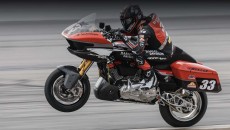Honda had arrived in Indonesia with great expectations after having ended the tests in front of everyone with Pol Espargarò, but things went very differently. Alberto Puig pointed to Michelin as the guilty party of this involution in performance: "I don't know what happened with the tyres, I have to talk in detail with Michelin" he declared. An attack that Piero Taramasso, the French tyre manufacturer manager, did not expect. The tyre casing was changed because, during those tests, Michelin realized that the standard tyre would not have withstood the stresses of the Mandalika circuit combined with the very high temperatures.
"I am surprised, I spoke to Puig because he wasn’t at the tests and I explained the whole situation to him, why we made this choice, I tried to give him all the elements that he probably did not have - Taramasso told us - All the technical staff of the teams and the overwhelming majority of the riders understood and in fact no one else complained. I am surprised that only he did not understand the motivation for this change between the testing and the Grand Prix ”.
We are talking about safety, right?
“Yes, we always put safety first, even when it comes to performance. The test tyres would not have held up to the race distance because the temperatures were very high and none of the compounds worked, all the riders and all the teams noticed it. At the end of the tests I talked to all the technical directors and team managers explaining the situation to them and telling them that there would be a change for the GP. The only possible technical solution was this casing that we had already used in 2017 and 2018, we paired it with the compounds used in the tests so as not to upset everything. These casings are able to lower the tyre temperature by 15-20°, that was what was needed ”.
How high did the asphalt temperature go?
“To 60°, we never saw such high temperatures at Sepang. Everyone was aware of this change, it is strange that there was someone who did not understand or want to understand, so I was surprised. There is no point in talking about safety if you only complain about performance. Also, some riders (referring to Pol Espargarò, ed.) believed that the tyres were from 2018, in the sense that they had been in the warehouse for 4 years (laughs). It takes a lot of imagination to think that, these tyres were produced after testing. There were a lot of strange things ”.
There are some observers who blamed the tyres also for Marquez's accident in the warm up.
"We analyzed the crash data and I can rule out that it was due to the tyres."
So the choice was: less performance, but more safety.
“That’s the point. This type of tyre has a little less grip but offers more stability to the bike. If we talk about pure performance, perhaps it is a bit lower, but over the weekend the riders did the same times as in the tests, when they had lapped for three days on a dry track. Quartararo's time in qualifying is the same as Pol Espargarò's in tests with standard tyres, which are a bit more performing. In this case our goal was to have the right tyres to do 27 laps and, if it hadn't rained, most of the riders would have started with the soft rear tyre ”.
Wasn't the decision to shorten the race by 7 laps due to the tyres?
"No, because of the asphalt conditions, in fact they had also shortened the Moto2 race. The tyres held up well, we had worked hard to do it, as did the teams who had worked hard to make them last for 27 laps. It was a technical challenge on everyone's part, when you change a tyre you have to work on the suspension, set-up, electronics, those who managed to adapt better and faster were in front, those who had a little more difficulty were behind. Races are like that”.
Will we see this type of tyre on other tracks over the course of the year?
“It was an exceptional case because Mandalika is a particular circuit, it’s a totally different story there, it has high cornering speeds, new asphalt and high temperatures. In Thailand and Austria we will bring another version of our tyres, let's say reinforced, which allow us to lower the temperature by 7-8°, in Indonesia it would not have been enough. It is a sort of intermediate tyre between the standard and the one used in Mandalika ”.
What are the plans for the Indonesian GP in view of 2023?
“We will have to see the calendar for next year, if we have the opportunity to do some tests we plan to evolve this tyre. Now we have a lot of data and we will be able to work on that particular tyre”.
Are you satisfied with the race in the wet?
“All the riders chose medium tyres both front and rear because the asphalt temperature was 30° and they knew it would dry quickly. With rain tyres the riders are always happy, the times were very fast, only 7 seconds slower than those in the dry, impressive. We now have both wet and dry data, so we can still improve for 2023 ".









